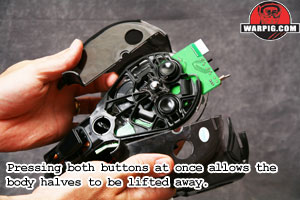  |
|
|
|
|
|
|
  |
|
|
|
|
|
|

Product Testing performed with DraXxus Paintballs provided by Procaps Direct What
do you think?
|
Empire Prophecy Loader
For players who have followed the development of the HALO loader, to the HALO B, to its being folded into National Paintball Supply (now KEE Action Sports) and morphing into the Reloader series and the Magna Loader, the Empire Prophecy can bee seen as the next iteration in the progression of that one particular loader's design. With a new body, and for the first time since the original gear drive HALO, a redesigned raceway and drive assembly, the Prophecy is packed with changes.
Although the spring loaded lock buttons allow the loader to be disassembled quickly, paintball hits in testing for review did not manage do dislodge any components.
The Prophecy is powered by four “AA” sized batteries, compared to six on the Magna, HALO and Reloaders. This arrangement delivers 6 volts to the loader's electronics, which is more than enough, considering that the use pulse width modulation to step the voltage down to 3 volts at the motor. While it was not uncommon for players to adapt HALO loaders to use 9volt transistor radio batteries instead of AA cells, the AA format provides a significant power density advantage. A bundle of four AA alkaline batteries has more than double the watt-hour capacity of a pair of 9-volts (based in independent discharge testing of Duracell Coppertops reported at Powerstream.com) with the same chemistry, yet takes approximately the same amount of space.

Arguably the biggest performance affecting differences between the Prophecy and its predecessors are the size of the drive system and its internal clutch system. The feed carousel in the HALO and Prophecy loaders is large enough to hold 10 paintballs. Its counterpart in the Prophecy is of a larger diameter and can hold 15. This larger size, at least in theory, provides a significant loading advantage. If the wheels in the two loaders are rotating at the same speeds, each paintball position in the Prophecy wheel will be exposed to the mass of paintballs in the loader 1.5 times as long as those in a HALO or Magna, increasing the odds that a paintball will have fallen into place by the time it reaches the feedneck, for improved reliability. Looking at the size change from another aspect, considering that the force of gravity is a limiting factor at dropping paintballs in to the raceway and carousel, the Prophecy's carousel could be spun at 1 and a half times the speed of that in a Magna Drive loader, while still providing an equal amount of time for paintballs to fall in each position. In this respect, bigger should be better, though the larger the wheel assembly becomes, the larger the loader must become, so the Prophecy design team needed to balance performance with practicality. The magnetic clutch system introduced in the Magna Loader is taken a step further with the addition of a magnetic tension system. The original HALO loader had a drive cone powered by direct gear linkage from an electric motor. This system had its limitations in the time needed to start and stop the drive cone. If it started too late, a ball would not be fed, and if it started too early or stopped too late it could smash paint. The next generation, the HALO-B added a belt drive (leading to the B in the name) and a spring. Instead of driving the cone directly, the motor, belt and gears wound a spring. With the drive cone under constant spring tension it would constantly press gently on the paint, feeding it the moment the breech opened. Small amounts of overrun by the motor would simply result in the spring winding a little more. In theory, large amounts of overrun by the motor would result in the belt slipping (this being the primary reason for the belt) rather than breaking paint. With the Magna Drive, a magnetic slip clutch was introduced to the design so that if the motor did over-drive past the point that the spring was fully wound, the clutch would slip, allowing the spring to unwind, rather than pushing too hard on the paint. This set-up allowed more driving force to be applied for faster loading speeds, while reducing the chance of paint breakage from overdriving.
The actual magnetic clutch operates as that in the Magna Drive loader, slipping if the motor drives longer than is needed.
Continue to Page 2.
|
| Copyright © 1992-2019
Corinthian Media Services. WARPIG's webmasters can be reached through our feedback form. All articles and images are copyrighted and may not be redistributed without the written permission of their original creators and Corinthian Media Services. The WARPIG paintball page is a collection of information and pointers to sources from around the internet and other locations. As such, Corinthian Media Services makes no claims to the trustworthiness or reliability of said information. The information contained in, and referenced by WARPIG, should not be used as a substitute for safety information from trained professionals in the paintball industry. |